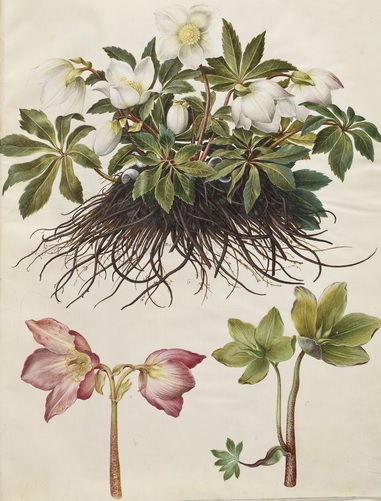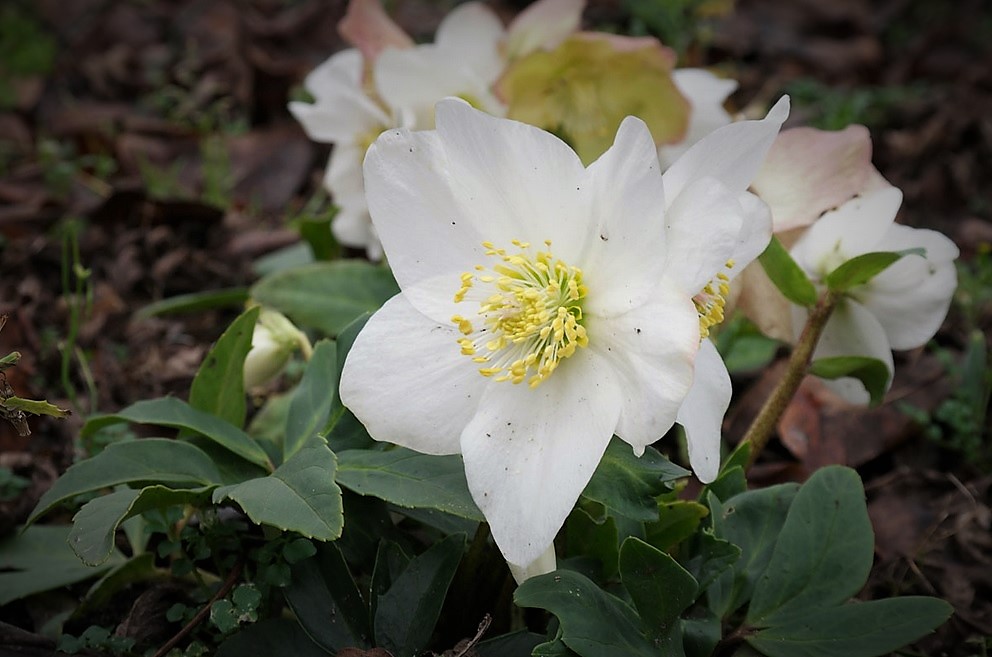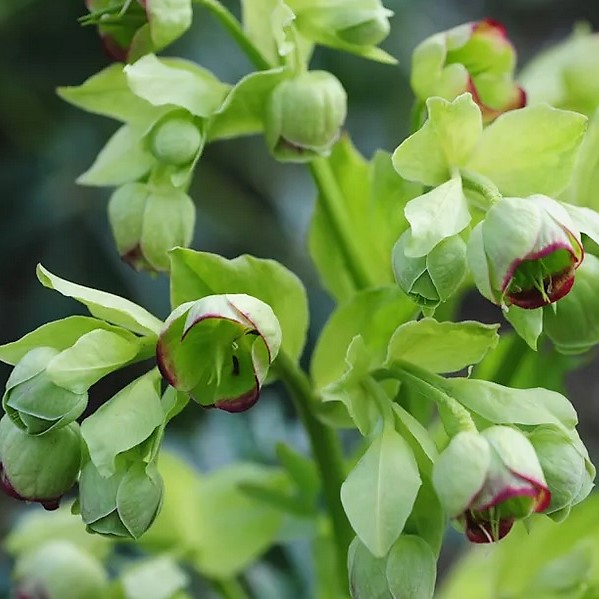 Helleborus niger & Helleborus foetidus
Helleborus niger & Helleborus foetidus
Black & Stinking Hellebore Varieties
Associated with Saturn,
Water, and
Mars, this classic
ritual magick herb is used for banishing and in
necromancy. It has also been used to heal mental/emotional afflictions and the ancient Greeks considered it to be a cure for insanity. In Greek mythology, hellebore was used to save King Argos's daughters from madness induced by Dionysus. Heracles was also said to have been cured of a fit of madness using this powerful plant. Although there are instances of hellebore being used for healing, this is one of the baneful herbs and
very dangerous, so approach it with respect.
Despite that, it seems to really enjoy keeping
people company, and has been cultivated since at
least the Middle Ages. It grows well in
temperate areas, especially in woodlands. As
a Saturn plant, it prefers
the kind of dappled shade found in deciduous
forests where it can get sunlight in
winter. It is in the Buttercup family, one of
the most poisonous, but like its siblings, it
burns the mouth when eaten, so people and other
animals rarely die of it. Always
wear gloves when working with it and do not ingest it in any form.
Top
 Black Hellebore (Helleborus niger)
Black Hellebore (Helleborus niger)
This is the oldest garden
type of hellebore, a classic magick herb, and a
wonderful addition to the witch's garden,
especially those dedicated to the Crone. It is often called Christmas rose because it is a winter-blooming evergreen perennial that blooms around the winter solstice in warm regions. The
flower color depends on the environment but is
usually white or pink. Cattle were once blessed
with this baneful herb to protect them against
malign influences and evil spells, and apparently
a ritual was involved in digging it up; it is too
bad that the knowledge of it has been lost. It is
also an ingredient in an incense for consecrating
talismans of Saturn. Agrippa recommended it as
part of a fumitory for raising spirits of Mars,
and it goes into the Cauldren of Cerridwen Brew. The black roots (where H. niger gets its name) can be prepared and carried like a mandrake.
 Stinking Hellebore (Helleborus foetidus)
Stinking Hellebore (Helleborus foetidus)
Also known as Setterwort, this
lovely evergreen perennial develops long-lasting clusters of pale green bell-shaped flowers that are often edged with a chartreuse ring. It blooms from winter to mid spring and is extremely hardy and adaptable. When stinking hellebore's flowers or foliage are bruised, the plant releases an aromatic grassy scent (a bit like the smell of wet dog or roast beef) that some find to be unpleasant--hence the name. This variety is somewhat easier to grow, preferring shady borders, woodland gardens, and even containers. It has even gained the Royal Horticultural Society's Award of Garden Merit.
Toxicity
This is a dangerous (baneful)
herb, so approach it with respect. Its root
contains aconitic acid, which is used in
perfumery, but its principal active chemicals
are glycosides (poisons). These toxins are chemically related to venom found in the skin of certain toads. As far back as
the ancient Greeks, a tincture of black
hellebore was used in single drop doses as a
drastic purgative in mental illness (it is a
CNS depressent) or to slow a rapid heart, but
in larger doses it causes death by convulsions
and heart failure, so it was not much
employed, especially since foxglove and
dogbane are less
dangerous.
Top
How
to grow Hellebore
The seed
needs warmth and then cold treatment to sprout. The best (and easiest) method is to plant the seeds around the fall equinox, since they require a 60-day (sometimes longer) moist chilling period, which occurs naturally in areas with cold winters. In zones 6-9 you can plant them outside in pots when you get
them and leave them outside through the warm
weather and then the cold until after Winter
Solstice (see special
directions on the Solstice Sowing page),
making sure that they have moisture but are not
soaked. They will likely germinate in February. Don't give up if they don't come up the first year. Hellebore is a Saturn plant (subject to Saturnian slowness) and germination can be delayed until the following year, so hold the pots outside for at least two years before giving up. Another method is to soak the seeds in water for 24 hours and then warm stratify by sowing them in good potting soil in flats or containers, covering them with a very thin layer of sandy soil or fine gravel, and maintaining constant humidity and a temperature of 72F/22C for 6-8 weeks. You can use bottom
heat from a waterproof heating pad for this (see
general growing
tips). If you live in a region with a cold winter, put the flats outside in an area like the one where you will plant them, just don't let them dry up. They should germinate in winter. Or you you can put them in the freezer for 6-8
weeks instead (0C/25-39F) and then raise the temperature to 50F
gradually (keep in fridge for a while). When you take them out, they should germinate. If the
cold treatment was not long enough, they will not
germinate until the following year. Seedlings should be
transplanted to their permanent site when they are
about two inches tall. Extremely heavy shade will mean a leggy
plant--long stalks and stems. Hellebore likes deep,
fertile soil that is
well drained (no standing water or clay) and has no
competition from tree roots. Plant out in dappled shade and choose a location that drains well but doesn't dry out completely. These plants
take two years to bloom, although some will bloom
the first fall. However, they will self-sow
prodigiously. Once they get growing, mulch
them before it gets too cold. Plants can be
flattened by very cold weather but will spring
back up. The farther south they are, the more
shade they like. Pick off dead leaves to
keep disease from getting hold. When they
get established, you can make root divisions in
July or just let them self-sow, which they do
readily. General
growing info.
Top
|
Helleborus niger
Black Hellebore
20
seeds $5.50
Helleborus foetidus
Stinking Hellebore
20
seeds $4.00

Uses in
Witchcraft & Magic:
Banishing
Witch's Garden (Crone)
Necromancy
Saturn/Water Herb
© 2004-2024 Alchemy Works; No reproduction without
permission
|
 Helleborus niger & Helleborus foetidus
Helleborus niger & Helleborus foetidus
